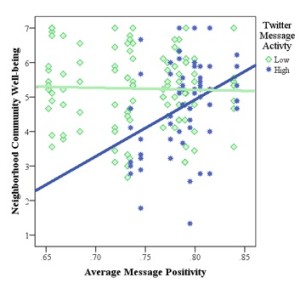
In neighborhoods that actively used Twitter, Twitter message positivity correlated with self-reported neighborhood community well-being.
With the transition leaving Microsoft Research and starting up Third Place Technologies, I have not had much time for revising this paper, but still wanted to throw it out for people to read if they are interested. This line of research has hugely influenced my own thinking in this space, including my decision to venture in to the non-profit sector to more proactively apply some of the lessons learned to real world problems.
Title: Neighborhood Community Well-being and Social Media
Shelly D. Farnham Microsoft Research (formerly), Michal Lahav, Living Research Labs Seattle, Andres Monroy-Hernandez, Microsoft Research, and Emma Spiro, University of Washington
Abstract: In the following study we adopt a multi-method approach to examine whether the growing use of social media as a channel for hyper-local conversation may provide meaningful insights into the well-being of neighborhood communities. First, through interviews and a questionnaire with 174 residents of 26 neighborhoods we explore what are indicators of neighborhood level well-being, and what are current communication practices around the use of social media to support community well-being. Second, through an analysis of neighborhood-level Twitter messages we examine the extent to which mood and social interactivity in Twitter correspond with our neighborhood well-being indicators. Overall, we found self-reported usage of social media positively correlated with community well-being. However, while smaller neighborhood communities had higher community well-being, they were lower in usage of social media for interacting with neighbors. Only in larger, more urban centers characterized by younger professionals, did Twitter message mood and social interactivity correlate with well-being.
| Indicators of Community Well-being | Percent Mentions |
| Thriving local businesses | 47% |
| Safe, low crime | 33% |
| Community events | 25% |
| Community resources | 25% |
| Friendly | 25% |
| Walkability | 25% |
| Gathering places | 24% |
| Social support | 20% |
| Well-maintained | 19% |
| Other health: mental, economic, physical | 19% |
| People know each other | 14% |
| Diversity (race, SES, age, families) | 12% |
| Vibrancy — people out and about | 11% |
| People interact/communicate | 11% |
| Civic engagement | 10% |
| Environmental/geographical assets | 10% |
| Growth – embracing change | 10% |
“What does this community have that indicates to you that it is healthy or unhealthy?”
